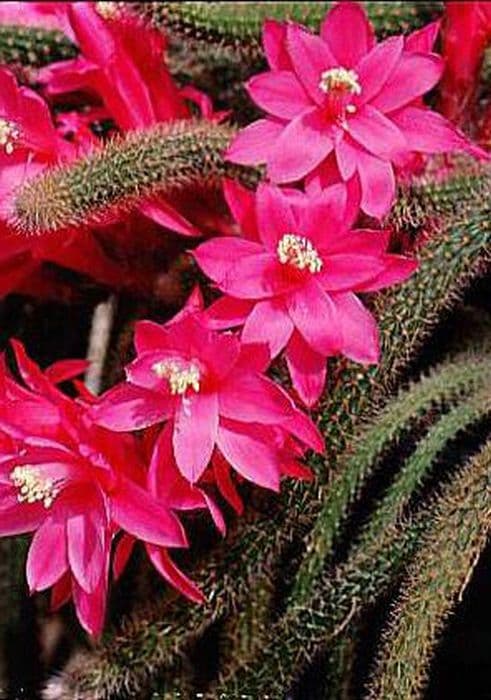Fishbone cactus Epiphyllum anguliger

ABOUT
The plant commonly known as Fishbone Cactus or Ric Rac Cactus is recognized for its distinctive, zigzagging stem pattern that resembles the bones of a fish. The stems of this plant are flat and thin, displaying a wavy pattern that gives it a unique and striking appearance. The color of the stems is typically a bright green, which may become tinged with a reddish or purplish hue under certain conditions, such as high light levels or stress. This cactus does not have conventional leaves; instead, its photosynthesis occurs in the green stems. The edges of the stems are gently serrated with soft curves or angles, contributing to the ric rac or fishbone appearance. They expand outwards and branch off from the main stem, creating a lush, hanging display when grown in a pot or basket. The Fishbone Cactus can also produce flowers which are typically large, white, and fragrant, opening at night to reveal long, tubular blossoms that can be quite showy. The visual texture of this plant is engaging, with a complex, organic rhythm to its form that can be almost hypnotic, making it a favorite among houseplant enthusiasts for its ornamental qualities.
About this plant
 Names
NamesFamily
Cactaceae.
Synonyms
Fishbone Cactus, Moon Cactus, Zig Zag Cactus, Rick Rack Cactus, Queen Of The Night, Orchid Cactus.
Common names
Phyllocactus anguliger, Phyllocactus latifrons, Cactus anguliger, Epiphyllum latifrons, Epiphyllum acuminatum, Epiphyllum anguliger var. microdentatum, Epiphyllum anguliferum, Epiphyllum anguligerum, Phyllocactus acuminatus, Phyllocactus angulifer, Phyllocactus anguliger, Phyllocactus anguliger var. microdentatus, Phyllocactus latifrons.
 Toxicity
ToxicityTo humans
The Fishbone Cactus (Epiphyllum anguliger) is not known to be toxic to humans. There are no well-documented symptoms of poisoning from ingesting this plant, as it is generally considered non-toxic. Therefore, ingesting parts of the Fishbone Cactus should not lead to any severe consequences for human health.
To pets
The Fishbone Cactus (Epiphyllum anguliger) is also considered non-toxic to pets. Similar to its effects on humans, there are no significant symptoms of poisoning associated with pets ingesting this plant. Pets that consume parts of the Fishbone Cactus should not experience serious health issues as a result of the ingestion.
 Characteristics
CharacteristicsLife cycle
Perennials
Foliage type
Evergreen
Color of leaves
Green
Flower color
White
Height
2 feet (60 cm)
Spread
2 feet (60 cm)
Plant type
Cactus
Hardiness zones
10
Native area
Mexico
Benefits
 General Benefits
General Benefits- Aesthetic Appeal: The unique fishbone pattern of Epiphyllum anguliger, also known as Fishbone Cactus, adds visual interest to any indoor space.
- Easy Care: Fishbone Cactus is tolerant of neglect and can thrive with minimal care, making it ideal for beginners or those with a busy lifestyle.
- Indoor Gardening: Suited for indoor environments, this plant can be a great addition to homes or offices without outdoor space.
- Low Light Adaptation: Fishbone Cactus can adapt to lower light conditions, unlike many other cacti, which require bright light.
- Pet Friendly: The Fishbone Cactus is non-toxic to cats and dogs, so it's safe to keep around pets.
- Night Bloomer: It produces beautiful, fragrant flowers that open at night, creating an interesting and unexpected display.
- Hanging Plant: Its cascading growth makes it ideal for hanging baskets, adding a different dimension to plant displays.
- Propagation Ease: Fishbone Cactus can be easily propagated from cuttings, allowing plant enthusiasts to share and expand their collection.
 Medical Properties
Medical PropertiesThis plant is not used for medical purposes.
 Air-purifying Qualities
Air-purifying QualitiesThis plant is not specifically known for air purifying qualities.
 Other Uses
Other Uses- Epiphyllum anguliger, commonly known as Fishbone Cactus, can be used as a unique ingredient in haute cuisine, where its subtle, exotic flavor and unusual texture create a novelty experience for diners.
- The striking form and pattern of the Fishbone Cactus make it an excellent subject for botanical illustration and art classes, serving as a reference for studies in symmetry and natural patterns.
- In eco-friendly fashion, the fibrous texture of the cactus can inspire textiles or patterns in clothing design that mimic its distinctive ribbed structure.
- Given its sculptural appearance, Fishbone Cactus can be a central element in terrariums or miniature gardens, adding a vertical dimension and visual interest.
- Fishbone Cactus can be used in sound insulation for rooms or studios due to its dense foliage, which may help to absorb sound waves.
- The plant can be incorporated into educational tools and children's books to introduce kids to the concept of epiphytic plants and unique life forms in nature.
- As a prop in theater and film, the Fishbone Cactus provides an exotic and alien visual that can enhance the setting of a scene with an otherworldly or jungle ambiance.
- Fishbone Cactus can be used as inspiration for jewelry design, where its form can be stylized into elegant and organic-looking pieces.
- This cactus could be part of a living sculpture or installation art, where it serves as an example of the beauty and complexity of natural growth patterns.
- During cultural or celebratory events, the Fishbone Cactus could be incorporated into floral arrangements or displays for its unique aesthetic and conversation-starting qualities.
Interesting Facts
 Feng Shui
Feng ShuiThe Fishbone Cactus is not used in Feng Shui practice.
 Zodiac Sign Compitability
Zodiac Sign CompitabilityThe Fishbone Cactus is not used in astrology practice.
 Plant Symbolism
Plant Symbolism- Uniqueness and Unconventionality: Epiphyllum anguliger, also known as Fishbone Cactus, features a distinctive zigzag or fishbone-shaped stem. Its unusual growth pattern sets it apart from other plants, symbolizing individuality and the beauty of standing out from the crowd.
- Adaptability and Resilience: As an epiphytic cactus, the Fishbone Cactus thrives by attaching to other plants but not harming them. It symbolizes the ability to adapt to various circumstances and environments while remaining self-sufficient and resilient.
- Creativity and Inspiration: The Fishbone Cactus blooms at night with beautiful, fragrant flowers, which are often seen as a source of inspiration. It is symbolic of creativity, the unfolding of artistic endeavors, and insight emerging in unexpected moments.
- Beauty in the Darkness: Since the Fishbone Cactus mostly blooms at night, it embodies the idea that there is beauty to be found even in darkness, reminding us that night-time can bring its own special kind of growth and beauty.
 Water
WaterThe Fishbone Cactus should be watered when the top inch of the soil feels dry to the touch, which typically means about once a week during the growing season. In the cooler, dormant months, water sparingly—every three to four weeks, allowing the soil to dry out completely between waterings. When watering, provide enough water so that it runs through the drainage holes, using approximately 8-16 ounces of water depending on the size of the pot. Avoid getting water on the leaves to prevent rot. During hot spells or in very dry air, mist the plant occasionally to increase humidity.
 Light
LightThe Fishbone Cactus thrives in bright, indirect light. A spot near a window with a sheer curtain is ideal, as the curtain diffuses the light, providing the plant with the bright conditions it prefers without exposing it to direct sun. Direct sunlight can scorch the leaves of the Fishbone Cactus, so it's important to avoid placing it in direct sun, especially during the hot afternoon hours.
 Temperature
TemperatureThe Fishbone Cactus enjoys warm temperatures, with an ideal range being between 60°F and 80°F. They can withstand temperatures as low as 50°F, but temperatures dropping below this point may damage the plant. Avoid placing your cactus near drafty windows or doors during the winter month.
 Pruning
PruningPruning the Fishbone Cactus is primarily done to maintain shape and encourage healthier, fuller growth. Pruning can be performed any time of year, but spring is best as the plant will be entering its active growing phase. Remove any dead or damaged branches to prevent disease and promote new growth. Pruning also helps manage the size of the cactus, which can be important if space is limited.
 Cleaning
CleaningAs needed
 Soil
SoilFishbone Cactus prefers a well-draining, organic-rich potting mix. A soil pH of around 5.5 to 6.5 is ideal. An effective mix could be composed of one-third potting soil, one-third orchid bark, and one-third perlite or pumice.
 Repotting
RepottingFishbone Cactus should be repotted every 2 to 3 years or when its roots outgrow the pot, which can be observed if roots are poking out of the pot's drainage holes.
 Humidity & Misting
Humidity & MistingFishbone Cactus thrives in humidity levels of 50-70%, making it suitable for most indoor environments without the need for additional humidity.
 Suitable locations
Suitable locationsIndoor
Place the Fishbone Cactus in bright indirect light indoors.
Outdoor
Grow Fishbone Cactus in dappled shade outdoors.
Hardiness zone
10-11 USDA
 Life cycle
Life cycleThe life of a Fishbone Cactus (Epiphyllum anguliger) begins with germination, where a seed sprouts in a suitable environment often within the crevices of a host tree or in decaying organic matter. This cactus then undergoes a vegetative growth phase, developing its characteristically zigzag or fishbone-patterned stems and absorbing water and nutrients from the air and rain through its aerial roots. As it matures, it produces beautiful, fragrant, nocturnal flowers that are typically white or cream-colored and bloom at night to attract pollinators, such as bats and moths. Following pollination, the cactus forms fruit that are typically elongated berries containing seeds, which may then drop to the ground or be disseminated by animals, allowing for the cycle to begin anew. Throughout its life, which can span several decades, the Fishbone Cactus can also propagate asexually through stem cuttings, which root easily and form new plants. This plant thrives in indirect light with regular, moderate watering, and during its life cycle, it will require periods of more intense growth in the warm season and rest during the cooler season.
 Propogation
PropogationPropogation time
Spring-Early Summer
The most popular method of propagation for the Fishbone Cactus (Epiphyllum anguliger) is through stem cuttings. To propagate, take a healthy stem section about 4 to 6 inches (10 to 15 cm) long, making the cut with a clean, sharp knife or pair of scissors. It's important to allow the cutting to dry and callous over for a few days to a week in a warm, dry, and shaded location to prevent rot. Once the cut end has hardened, plant the cutting in a pot filled with a well-draining soil mix, typically one suited for cacti and succulents. Water sparingly until roots have established, usually indicated by new growth. This method is typically done in spring to early summer when the plant is actively growing.








